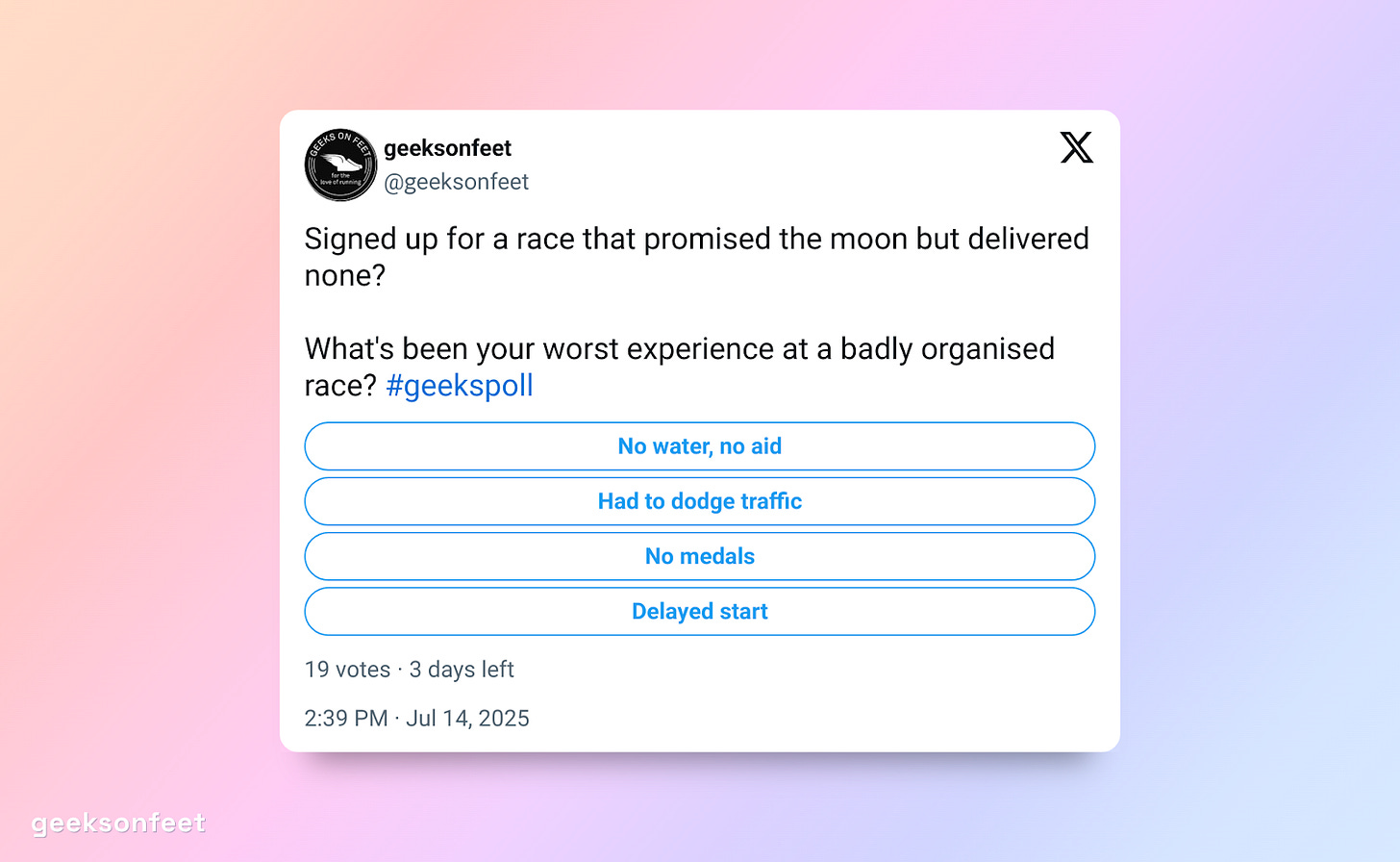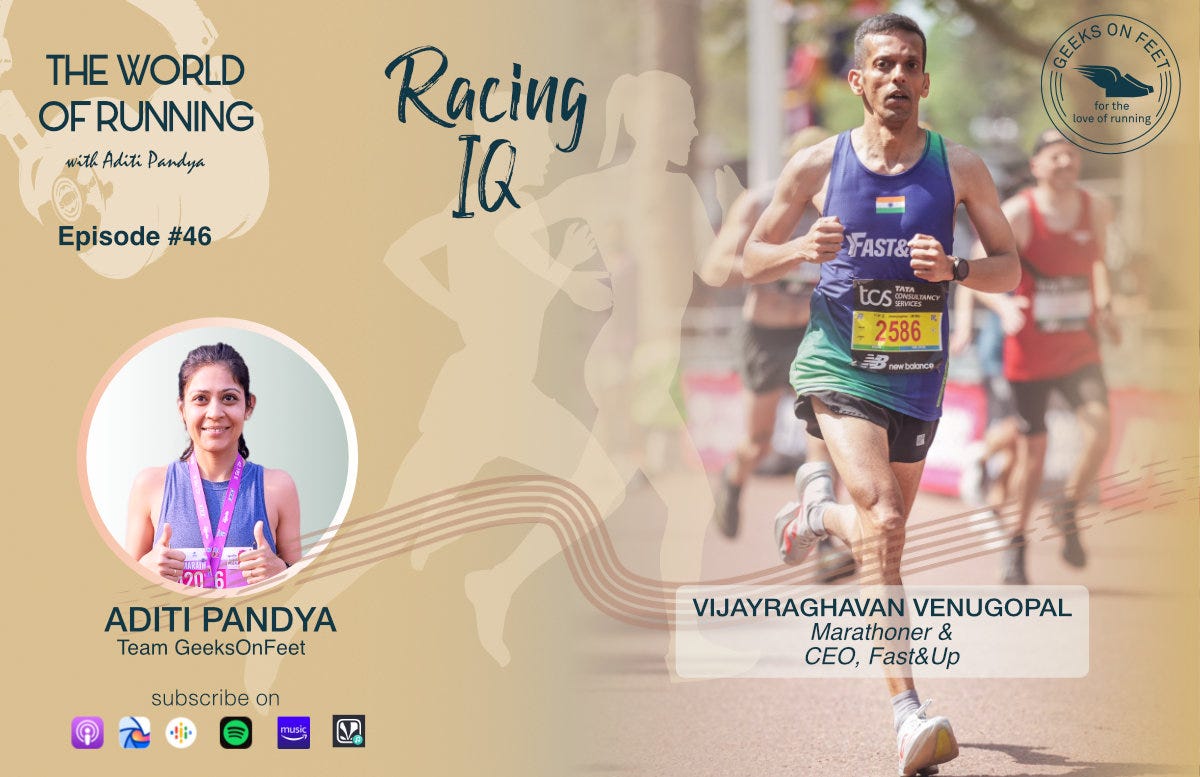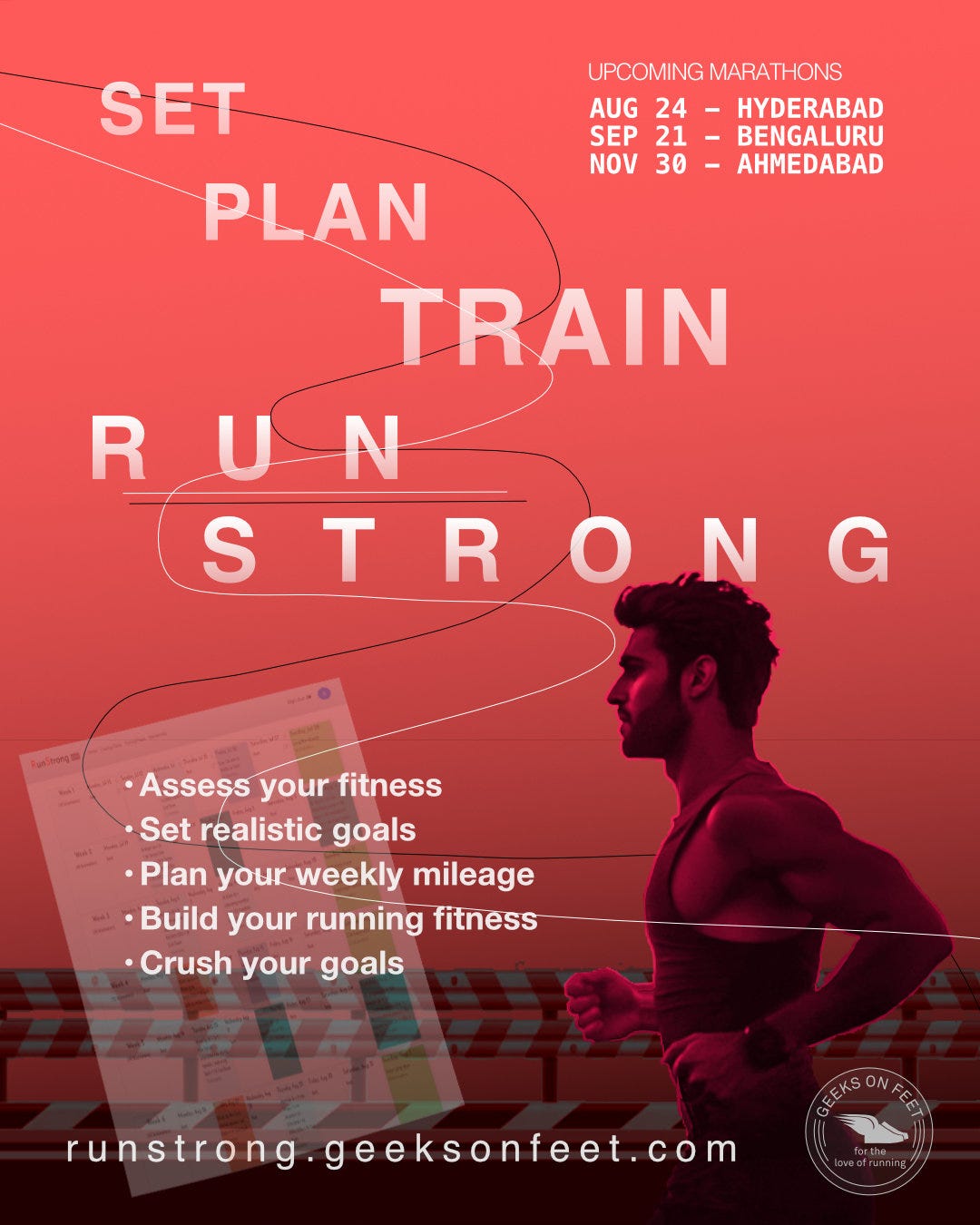Lets understand Racing IQ and everything around it.
#WhatsUpThisWeek?
What is the difference between a good race and a great race? It's the Racing IQ. Know all about it in this month’s podcast at #GeekonFeet
Hamstring bridges help improve stability, muscle balance, and running efficiency. In this week’s #WoW
Planning to self-train for the upcoming season, we have prepared a self-paced training plan for you at #Runstrong. Whether a beginner or seasoned runner, this plan has something for everyone.
Happy Reading!
#GeeksPoll
Signed up for a race that promised the moon but delivered none?
What's been your worst experience at a badly organised race? #geekspoll
Answer Live Poll Here.
The results of last week's poll on how runners identify themselves as are here.
#WoW - Hamstring Bridges
Hamstring bridges strengthen the hamstrings, glutes, and core, helping improve muscle balance and running efficiency. They enhance pelvic and core stability, boosting stride power.
How to do it?
Lie flat on your back with your arms at your sides, palms facing down.
Bend your knees to 90 degrees and place your heels on the floor.
The difference between glute and hamstring bridges is that in the former, the feet are closer to the glutes, and in the latter, they are away from the glutes with a focus on hamstring activation. Also, the toes are facing upwards, unlike the former.
Engage your core and squeeze your glutes.
Press through your heels and lift your hips off the ground until your body forms a straight line from shoulders to knees.
Hold at the top for 1–2 seconds, focusing on squeezing your hamstrings and glutes.
Lower your hips slowly back to the ground with control.
You can also hold the bridge for 10 to 15 seconds to improve the posterior chain strength and isometric endurance.
@GeeksOnFeet: Ep 46: RacingIQ
Racing IQ is the difference between a good run and a great race finish. In this episode, Aditi Pandya talks with 6-star finisher and sub-3 marathoner Vijayaraghavan Venugopal on pacing, making smart race-day decisions, and handling chaos mid-race. Learn how to build instincts that help you race smarter. Listen or watch here.
RUN STRONG - Training Plans
Prepares you for the course evaluations
Personalised for your goals
Customised to your fitness
Can be planned per your schedules
Access the plans now at https://runstrong.geeksonfeet.com/training-plans/
#RunSHORTS
World's 'oldest' marathon runner, Fauja Singh, dies at 114 in hit-and-run
Fauja Singh, a British-Indian man believed to be the world's oldest marathon runner, has died after being hit by a car in India at the age of 114. Police say Singh was crossing a road in the village where he was born in Punjab when an unidentified vehicle hit him. Locals took him to hospital, where he died. Singh, a global icon, set records by running marathons across multiple age categories, including when he was over 100. He began running at 89 and ran nine full marathons between 2000 and 2013. The police arrested Amritpal Singh Dhillon late on Tuesday in Kartarpur, his home town, who had recently returned from Canada and was the one driving the SUV at the time of the accident. Read more here and here
Vedanta Delhi Half-Marathon registrations begin
Registrations for the Vedanta Delhi Half Marathon begin today, July 17th, for various race categories, including the half marathon, Open 10K, Great Delhi Run, Senior Citizens Run, and Champions with Disability, according to Sportstar. The event will take place on October 12th, starting at Jawaharlal Nehru Stadium. Registrations will remain open until September 19th or until all running slots are filled. Read more here.
At RunMechanics, we have assessed 400+ runners. Click here to book your appointment
Race Calendar
Search and find races using our Race Finder at geeksonfeet.com/races.
#TipOfTheWeek: Reset Your Legs and Your Nervous System in Just 8 Minutes
After your next key run workout or strength session, try this simple method: 8 minutes with your legs up + 4-7-8 nasal breathing.
Here’s how to do this:
Lie down and elevate your legs against a wall or couch (hips close, heels above heart).
Set a timer for 8 minutes.
Breathe in through your nose for 4 seconds, hold for 7, then exhale slowly for 8 (soft humming sound optional). Repeat for 10 cycles, and after that, breathe slowly and in a relaxed manner.
Bonus move: Add gentle ankle pumps every minute to improve circulation.
Here’s why it works
Reduces swelling and improves blood return from tired legs
Lowers heart rate and boosts parasympathetic recovery
Increases HRV and primes your body to bounce back stronger
Think of it as a mini "reset button" for both your legs and your nervous system. Try it 2-3 times a week after tough sessions.
Support Us
Our mission is to empower the running community by providing valuable insights into all aspects of running. Through our weekly updates, we’ve been able to make a significant impact, reaching runners across India and beyond.
This wouldn’t be possible without the incredible support and feedback from our community. If you’ve found value in our work and appreciate our efforts, we kindly ask for your support through a donation. Your contribution will enable us to continue delivering high-quality content and help us make an even greater impact.
Thank you for being an integral part of our journey!
Contributors to this edition: Aditi Pandya, Karthik Nadar, and Aravind Yarra






